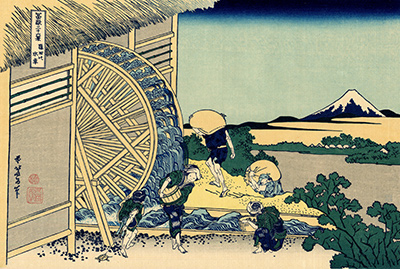Hokusai
Watermill at Onden
Now located across two of Tokyo’s busiest districts, Onden once resided behind the Zenko-ji Temple in the Aoyama district. It was then a small farming village littered with many waterwheels, powered by the great Shibuya river.
It is one of these watermills that is depicted by the distinguished Japanese artist, Katsushika Hokusai, in his ‘Watermill at Onden’. The image is one of a series of 36, which Hokusai started in 1830 at the age of 70; by the time of his death in 1849 the original 36 images had expanded to 146! The series, known as ’36 views of Mount Fuji’, is largely responsible for bringing Hokusai his well-deserved world-wide recognition. All 36 paintings, as the title suggests, feature Mount Fuji. The unchanging mountain can be seen as a backdrop to a bamboo grove, across a rice field, beside a tea-house after a snowfall, and arguably the most famous of the images, under a wave off Kanagawa.
Hokusai’s series of landscape prints were created using woodblocks. This medium of print became popular in Japan in the Edo era (1603-1868) and was used for book printing as well as art. An image, drawn on paper, was then carved into a block of wood. Then by immersing the block into ink and applying it to paper, the image could be reproduced. We can understand the complexity of Hokusai’s prints when we consider the wide range of colours he used, which required a separate block for each colour.
‘Watermill at Onden’ is particularly noted, along with several others, for it’s use of Prussian Blue, a new pigment that began to be imported into Japan in the 1820s and which Hokusai quickly made use of. Before the introduction of Prussian blue, pigments such as indigo dye and smalt were used which had a tendency to fade. This new blue dye was rich and gave a greater sense of depth than had been achievable before. The artwork portrays peasants at work around the mill, with Mount Fuji a silent observer on the horizon. Men carry sacks into the mill house whilst two women wash the contents of their baskets in water from the mill wheel. The fifth occupant of the image, a young boy, leads a pet turtle on a string, Turtles are associated with long life and perhaps tap into Hokusai’s obsession with immortality, also associated with the mountain.
The sacred Mount Fuji has long been associated with infinite life in Japanese culture, due in part to the ‘Tale of the Bamboo Cutter’ where the panacea of life is left on the peak of the mountain by a Goddess. Hokusai was fascinated both by the mountain and the idea of eternal life. In Hokusai’s own words, he saw himself reaching at least the age of 110: “From the age of 6, I had a passion for copying the form of things … by 100 I shall perhaps truly have reached the level of the marvellous and divine. When I am 110, each dot, each line will possess a life of its own”. Sadly even Hokusai couldn’t fathom the secret of immortality, dying in 1849 at a respectable age of 88. But with his works and that of his contemporaries having a considerable influence on Japonism and art nouveau in Europe, he lives on through his creations and so perhaps, in a way, he did achieve his immortality after all.
